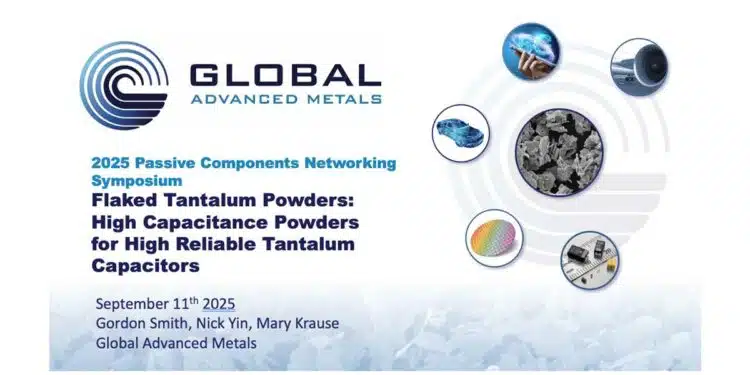The paper “Flaked Tantalum Powders: High Capacitance Powders for High Reliable Tantalum Capacitors” was presented by Gordon Smith, Global Advanced Metals, Boyertown, Pennsylvania, US at the 5th PCNS Passive Components Networking Symposium 9-12th September 2025, Seville, Spain as paper No. 4.1.
Introduction
Tantalum-based capacitors are critical components for electronic devices requiring reliability under diverse environmental conditions.
Their ability to maintain stable capacitance across varying temperatures and voltages, combined with long lifetime, high volumetric efficiency, and absence of piezoelectric effects, make them vital in demanding applications such as servers, automotive systems, and space technologies.
To achieve high performance, the selection of the appropriate tantalum powder for the capacitor anode is essential. This article explores the characteristics, production, and benefits of flaked tantalum powders in comparison with traditional nodular powders, demonstrating their suitability for high-capacitance and high-reliability applications.
Key Points
- Tantalum capacitors rely on high surface area tantalum pentoxide dielectrics for capacitance.
- Particle size and morphology of tantalum powders directly influence volumetric efficiency, capacitance, and reliability.
- Flaked powders, with plate-like geometries, provide higher specific charge and reduced leakage current, particularly at higher formation voltages.
- Manufacturing processes for flake powders include mechanical deformation of nodular or angular powders followed by heat treatment and purification.
- Flake powders improve volumetric efficiency and electrical reliability compared to nodular powders, especially in high-voltage applications.
Extended Summary
Modern tantalum capacitors trace their origins to the 1950s and maintain a basic construction composed of a tantalum anode, a tantalum pentoxide dielectric, and a cathode layer of MnO₂ or conductive polymer. The manufacturing process involves pressing high-purity tantalum powder with a binder around a tantalum wire, removing the binder, sintering the pellet at high temperatures to create a porous yet mechanically strong structure, and anodizing it to form a tantalum pentoxide dielectric. The capacitor is completed with a cathode layer and conductive carbon and silver coatings. The dielectric layer’s thickness, controlled by formation voltage, is critical to the capacitor’s ultimate electrical performance.
Tantalum powder morphology has evolved from early angular powders to nodular and dendritic forms to optimize surface area and capacitance. Angular powders, with irregular shapes, suffered from inefficiency and high leakage due to sharp edges and broad particle size distributions. Nodular powders offered improved control over particle and pore sizes, enhancing capacitance and reliability across a wide formation voltage range. Dendritic powders, with nanoscale primary particles, are used for very low-voltage, high-capacitance applications. Flaked powders, produced by mechanically deforming angular or nodular powders into thin platelets, combine the benefits of nodular powders with the unique advantages of high-aspect-ratio geometries.
The production of tantalum powders involves hydrometallurgical extraction, chemical purification, and sodium reduction of K₂TaF₇ to form a basic powder. Flake powders are created by mechanically milling nodular or angular powders using media mills such as ball or rod mills, which flatten the ductile tantalum into platelets. Further treatments, including heat, deoxidation, nitriding, and acid washing, refine the powders to meet strict electrical and physical specifications.
Flake powders demonstrate superior volumetric efficiency because their platelet structure increases the exposed surface area per unit volume, thereby raising the achievable capacitance. Experiments comparing flake powders C275 and C255 with nodular powder C350 show that specific charge capacity depends on formation voltage, with C275 excelling below 200 Vf and C255 outperforming at higher voltages due to better structural integrity at thick dielectric layers. Theoretical models confirm that flake geometries can achieve higher maximum charge capacities than nodular counterparts due to their favorable surface-to-volume ratios.
In terms of electrical reliability, flake powders reduce leakage currents because their lower curvature surfaces induce less mechanical stress during dielectric growth. This minimizes defect formation in the tantalum pentoxide layer, which is crucial for long-term stability. Comparative tests reveal that flake powders exhibit significantly lower leakage currents than nodular powders, and the performance gap widens at higher formation voltages. C255, in particular, provides excellent leakage current characteristics, making it preferable for applications prioritizing reliability over peak capacitance.
Conclusion
Flaked tantalum powders present a compelling solution for high-capacitance, high-reliability capacitor applications. Their platelet morphology enhances volumetric efficiency and reduces leakage current, offering clear advantages over traditional nodular powders, especially in high-voltage environments. With established manufacturing processes and compatibility with both MnO₂ and polymer capacitor technologies, flake powders allow capacitor manufacturers to optimize product performance for demanding applications in automotive, aerospace, and advanced electronics.






























